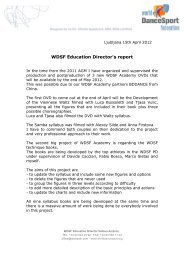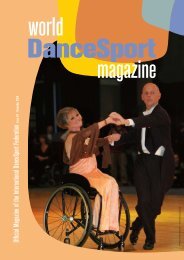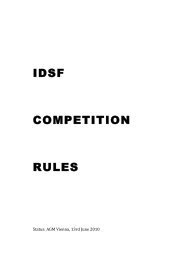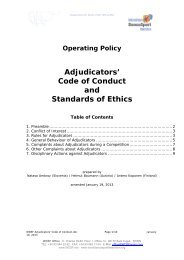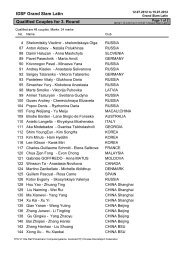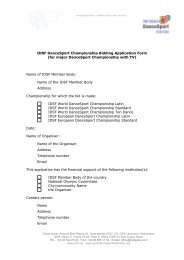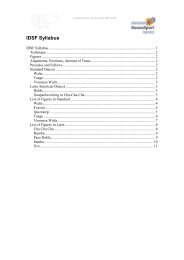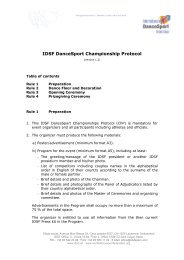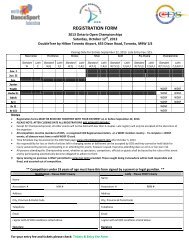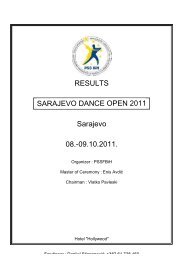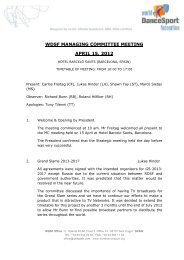Ranking Regulations 2012 Onwards - World DanceSport Federation
Ranking Regulations 2012 Onwards - World DanceSport Federation
Ranking Regulations 2012 Onwards - World DanceSport Federation
Create successful ePaper yourself
Turn your PDF publications into a flip-book with our unique Google optimized e-Paper software.
IDSF COMPUTER WORLDRANKING LISTREGULATIONS FOR THE CONDUCT OFIDSF WORLD RANKING TOURNAMENTS1 Categories of <strong>World</strong> <strong>Ranking</strong> Tournaments:1.11.21.3IDSF <strong>World</strong> OpenIDSF International OpenIDSF Open2 Adjudicators2.1IDSF <strong>World</strong> Open:A minimum of 9 adjudicators from at least 8 IDSF membercountries nominated by the organiser and confirmed by IDSF.The number of adjudicators can be moved to 11 adjudicatorsfrom at least 9 IDSF member countries, to 13 adjudicatorsfrom at least 11 IDSF member countries.2.2IDSF International Open:A minimum of 7 adjudicators from at least 6 IDSF membercountries nominated by the organiser and confirmed by IDSF.The number of adjudicators can be moved to 9 adjudicatorsfrom at least 6 IDSF member countries, to 11 adjudicatorsfrom at least 8 IDSF member countries or to 13 adjudicatorsfrom at least 10 IDSF member countries.2.3IDSF Open:A minimum of 5 adjudicators from at least 4 IDSF membercountries nominated by the organiser and confirmed by IDSF.The number of adjudicators can be moved to 7 adjudicatorsfrom at least 5 IDSF member countries, 9 adjudicators from atleast 6 IDSF member countries, 11 adjudicators from at least7 IDSF member countries or 13 adjudicators from at least 8IDSF member countries.IDSF Office · C. Oriente 78-84, Floor 1, Office 14 · 08172 Sant Cugat · SPAINTEL: +34 93 544 23 92 · FAX: +34 93 583 11 04 · E-Mail: office@idsfspain.comwww.idsf.net · www.worlddancesportfederation.org
3 Chairman3.1IDSF <strong>World</strong> Open:Chairman, nominated by the organiser and confirmed by IDSF.3.2IDSF International Open:Chairman, nominated by the organiser and confirmed by IDSF.3.3IDSF Open:Chairman, nominated by the organiser and confirmed by IDSF.The chairman is responsible for the observance of the IDSF-Rules and the Management of IDSF <strong>World</strong> <strong>Ranking</strong>Tournaments. He has to report about the competitions to theIDSF Sports Director following the guidelines of the IDSFOperating Policy Duties and Obligations of IDSF Chairmen andIDSF Operating Policy Chairman Report Checklist.4 Number and nationalities of couples in IDSF WORLDRANKING TOURNAMENTS4.1IDSF <strong>World</strong> Open:A minimum of 48 couples from 10 IDSF member bodies.4.2IDSF International Open:A minimum of 36 couples from 8 IDSF member bodies.IDSF Open:4.3A minimum of 24 couples from 4 IDSF member bodies.4.4 If the minimum requirements are not fulfilled there is areduction of the ranking points.4.5 If the minimum requirements of number and nationalities ofcouples for the IDSF <strong>World</strong> Open and IDSF International Openevents are not fulfilled during one Competition Year, the IDSFMember Body is only allowed to organize 2 IDSF InternationalOpen for the next year.IDSF Office · C. Oriente 78-84, Floor 1, Office 14 · 08172 Sant Cugat · SPAINTEL: +34 93 544 23 92 · FAX: +34 93 583 11 04 · E-Mail: office@idsfspain.comwww.idsf.net · www.worlddancesportfederation.org
4.6 IDSF Member Bodies can apply for a maximum of 2 IDSF<strong>World</strong> Open per year and discipline, with the followingconditions:1. Having organized 4 IDSF International Open per yearand discipline2. Provide the finalists with at least SFR 2’400 (1-600, 2-500, 3-400, 4-300, 5 and 6 – 200)5 IDSF <strong>World</strong> <strong>Ranking</strong> PointsIDSF <strong>World</strong> <strong>Ranking</strong> Points are given to the participatingcouples in the following IDSF Competitions as follows:5.1IDSF Grand Slam:<strong>Ranking</strong> points to all couples according to the IDSF <strong>Ranking</strong>Points schedule.5.2IDSF <strong>World</strong> Open:<strong>Ranking</strong> points to all couples according to the IDSF <strong>Ranking</strong>Points Schedule.5.35.4IDSF International Open:<strong>Ranking</strong> points to all couples according to the IDSF <strong>Ranking</strong>Points Schedule.IDSF Open:<strong>Ranking</strong> points to all couples according to the IDSF <strong>Ranking</strong>Points Schedule.6 IDSF <strong>Ranking</strong> Points ScheduleSee enclosureThe points in the schedule for IDSF International Open andIDSF Open are basis points. The points get an addition orreduction according enclosed list. The calculation will be madeby the IDSF Sports Director.IDSF Office · C. Oriente 78-84, Floor 1, Office 14 · 08172 Sant Cugat · SPAINTEL: +34 93 544 23 92 · FAX: +34 93 583 11 04 · E-Mail: office@idsfspain.comwww.idsf.net · www.worlddancesportfederation.org
IDSF Computer <strong>World</strong> <strong>Ranking</strong> List that means, a couple canhave results being cancelled. The result of the IDSF <strong>World</strong>Championships, Adult, Youth and Senior, is in the IDSFComputer <strong>World</strong> <strong>Ranking</strong> List up to the next IDSF <strong>World</strong>Championship. The basis to give exemptions in IDSF <strong>World</strong><strong>Ranking</strong> Tournaments is always the status of the CWR List ofthe fist of the month before the competition.9 ExceptionsFor Competitions outside of Europe IDSF can make specialexceptions from these regulations.IDSF Office · C. Oriente 78-84, Floor 1, Office 14 · 08172 Sant Cugat · SPAINTEL: +34 93 544 23 92 · FAX: +34 93 583 11 04 · E-Mail: office@idsfspain.comwww.idsf.net · www.worlddancesportfederation.org
IDSF RANKING POINTS SCHEDULEIDSF GRAND SLAMIDSF WORLD OPENPLACE POINTS PLACE POINTS1 400 1 3202 380 2 3003 360 3 2804 340 4 2605 320 5 2406 300 6 2207 280 7 2008 260 8 1809 240 9 16010 220 10 14011 200 11 1<strong>2012</strong> 180 12 10013 140 13 9614 135 14 9215 130 15 8816 125 16 8417 120 17 8018 115 18 7619 110 19 7220 105 20 7821 100 21 7422 95 22 6023 90 23 5624 85 24 5225-30 70 25-30 4831-36 60 31-36 4437-42 40 37-42 4043-48 36 43-48 3649 and more 16 49-96 1697 and more 8IDSF Office · C. Oriente 78-84, Floor 1, Office 14 · 08172 Sant Cugat · SPAINTEL: +34 93 544 23 92 · FAX: +34 93 583 11 04 · E-Mail: office@idsfspain.comwww.idsf.net · www.worlddancesportfederation.org
1. Main story1.1 Brief historyThe project started in 1982. Prof. Zaslavsky’s interest was aroused when working on the engineering of the socalled stratified, or density gradient, “solar ponds” with “Ormat” in the northern end of the Dead Sea. He becameconvinced that renewable energy for electricity would be more efficient and, in all possibility, more economicalif it did not require the installation of a solar radiation collector. There is no theoretical proof of this; but, so far,there is no practical exception.The oldest forms of energy used by man are renewable (wind, hydro-power, bio-mass), and do not require theuse of a structured solar collector. The construction of a convective Tower with air downdraft, as described here,is another possible source of this type.Prof. Zaslavsky of the Technion--Israel Institute of Technology in Haifa, later found out that Dr. Philip Carlsonhad used the main principles required to implement and develop such an idea. He has been granted a U.S. patentin 1975. Several very important improvements were added by the Technion team headed by Zaslavsky to reducethe cost effectiveness ratio by a factor of about 1:7.The project was supported mainly by the Israeli Ministry of National Infrastructures (formerly the Ministry ofEnergy), by financial contributions of the American Technion Society - Baltimore Chapter, different researchfoundations and primarily by the Technion itself. The Israeli Electric Corporation followed the project’sprogress, reviewed it and helped financially and professionally.Scientists and engineers of 5 departments, including 13 professors and 8 engineers with Doctorate degrees,participated in the project. Nearly 20 theses for higher degrees were involved. All in al, over 100 men-years werespent on the Energy Towers development.A patent was requested in 15 countries and already approved in some, and close to be formally confirmed inother countries.The first expert reviewing committee included 12 members. This committee was nominated by Prof. Haim Eilataand Gur Arieh Eitan, then the Chief Scientist of the Ministry of Energy and the head of R&D division,respectively(early 1983). All their conclusions were positive.In 1994, the Israeli Minister of Energy nominated a 7 member expert committee, headed by Prof. M. Sokolov ofTel Aviv University, to review the project. Among the committee members were: two experts inthermodynamics and hydrodynamics; an expert in weather physics (climate in general and rain formation inparticular); a structural engineer; the Chief Scientist of the Ministry of Energy; an electrical engineer with wideexperience in erecting different types of power stations; and the head of the R and D division of the IsraeliElectric Corporation. Each one of them employed his own professional team. The Committee also hiredprofessionals for special tasks such as redesign of the main shaft construction. It also consulted representatives ofthe Water Commission for the State of Israel, the Ministry of Commerce and Industry and the Ministry ofEnvironment. The work continued over more than one year and 18 special brochures were prepared for thebenefit of the reviewer. The committee conclusions’ were: All physical principles were proven and re-proven beyond doubt. The project can be built completely by proven technologies. There is a wide economic advantage compared to the conventional sources of energy. There are several know-how gaps that could be bridged with good chances to further improve theeconomy.7



